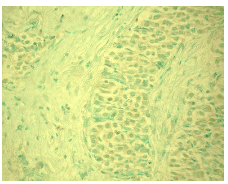biological source
mouse
antibody form
purified antibody
antibody product type
primary antibodies
clone
2A9C1.18, monoclonal
form
liquid
does not contain
preservative
species reactivity
mouse, human
manufacturer/tradename
Calbiochem®
storage condition
OK to freeze
avoid repeated freeze/thaw cycles
isotype
IgG2a
shipped in
wet ice
storage temp.
−20°C
Gene Information
human ... MDM2(4193)
mouse ... Mdm2(17246)
General description
Increased expression of proto-oncogenes due to gene amplification can lead to cellular transformation in the absence of other mutagenic events. Recently, a novel gene termed MDM2, first identified in mouse as a small acentromeric extrachromosomal element, was shown to become oncogenic upon amplification and tumorigenic when overexpressed in NIH3T3 and Rat2 cells. The human homolog of MDM2 gene has been isolated and mapped to chromosome 12q13-q14, a region that is found to be amplified in human sarcomas. Sequence analysis of the murine, rat, and human MDM2 genes suggests that MDM2 may be involved in transcriptional regulation. MDM2 contains two putative metal-binding motifs, one of which shares similarity to known zinc finger transcriptional activators. MDM2 also contains a putative nuclear localization signal and an acidic domain of the type found in transcriptional activators. A functional role for MDM2 has recently been identified on the basis of experiments which demonstrate that MDM2 forms a stable complex with p53 in vivo. Furthermore, over-expression of MDM2 inhibits the ability of wild type p53 to stimulate expression of target genes and this inhibition appears to result from MDM2 binding to the acidic activation domain of p53, thereby preventing p53 from directly contacting the transcriptional machinery. Interestingly, wild type p53 appears to positively regulate expression of the MDM2 gene. MDM2 amplification has been observed in sarcomas and direct analysis of the MDM2 and p53 genes in sarcomas indicates that one or the other but not both of these genes is mutated in 70% of the tumors. Thus, it appears that genetic alterations in either p53 or MDM2 represent alternative mechanisms for inactivating the same growth suppressive pathway. Regulation of MDM2 expression by p53 also represents a potential feed back control of p53 function.
Purified mouse monoclonal antibody. Recognizes the ~90 kDa (apparent MW) MDM2 protein.
Recognizes the ~90 kDa (apparent MW) MDM2 protein in A549 cells.
Immunogen
Epitope: within amino acids 153-222
Human
recombinant, human MDM2
Application

Immunoblotting (2 g/ml, chemiluminescence)
Immunofluorescence (1 g/ml)
Immunoprecipitation (1 g/reaction)
Paraffin Sections (2.5 g/ml, heat pre-treatment required)
Packaging
Please refer to vial label for lot-specific concentration.
Physical form
In 50 mM sodium phosphate buffer, 50% glycerol.
Preparation Note
Following initial thaw, aliquot and freeze (-20°C).
Analysis Note
Positive Control
A549 cells or most tissues
A549 cells or most tissues
Other Notes
Antibody should be titrated for optimal results in individual systems.
Marchetti, A., et al. 1995. J. Pathol.175, 31.
Barak, Y., et al. 1993. EMBO. J.12, 461.
Ladanyi, M., et al. 1993. Cancer Res.53, 16.
Leach, F. S., et al. 1993. Cancer Res.53, 2231.
Oliner, J.D., et al. 1993. Nature362, 857.
Momand, J., et al. 1992. Cell69, 1237.
Oliner, J.D., et al. 1992. Nature358, 80.
Fakharzadeh, S.S., et al. 1991. EMBO J.10, 1565.
Barak, Y., et al. 1993. EMBO. J.12, 461.
Ladanyi, M., et al. 1993. Cancer Res.53, 16.
Leach, F. S., et al. 1993. Cancer Res.53, 2231.
Oliner, J.D., et al. 1993. Nature362, 857.
Momand, J., et al. 1992. Cell69, 1237.
Oliner, J.D., et al. 1992. Nature358, 80.
Fakharzadeh, S.S., et al. 1991. EMBO J.10, 1565.
Legal Information
CALBIOCHEM is a registered trademark of Merck KGaA, Darmstadt, Germany
Disclaimer
Toxicity: Standard Handling (A)
Not finding the right product?
Try our Product Selector Tool.
Storage Class Code
10 - Combustible liquids
WGK
WGK 2
Certificates of Analysis (COA)
Search for Certificates of Analysis (COA) by entering the products Lot/Batch Number. Lot and Batch Numbers can be found on a product’s label following the words ‘Lot’ or ‘Batch’.
Already Own This Product?
Find documentation for the products that you have recently purchased in the Document Library.
The p53 Codon 72 Polymorphism Modifies the Cellular Response to Inflammatory Challenge in the Liver.
Julia I-Ju Leu et al.
Journal of liver, 2(1) (2013-08-31)
The p53 protein is a critical stress-response mediator and signal coordinator in cellular metabolism and environmental exposure to deleterious agents. In human populations, the p53 gene contains a common single nucleotide polymorphism (SNP) affecting codon 72 that determines whether a
Mao Ye et al.
Oncotarget, 6(33), 34718-34731 (2015-10-16)
The ubiquitin-specific protease USP7 stabilizes both Mdm2 and p53 by removing ubiquitins, hence playing an important enzymatic role in the p53-Mdm2 pathway. However, it is poorly understood how USP7 executes its dual-stabilization effect on Mdm2 and p53 in cellular context.
Xiongbin Lu et al.
Cancer cell, 12(4), 342-354 (2007-10-16)
The tumor suppressor p53 is a transcription factor that responds to cellular stresses by initiating cell cycle arrest or apoptosis. One transcriptional target of p53 is Mdm2, an E3 ubiquitin ligase that interacts with p53 to promote its proteasomal degradation
Our team of scientists has experience in all areas of research including Life Science, Material Science, Chemical Synthesis, Chromatography, Analytical and many others.
Contact Technical Service